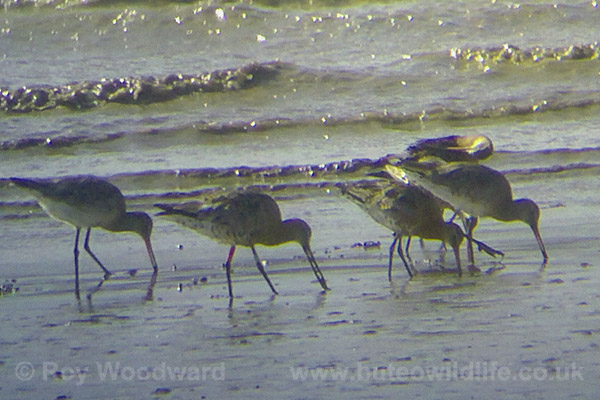Today I spent the morning and early part of the afternoon by the River Thames, not far outside of London, at East Tilbury. I was with someone who wanted to try and find some waders and other wildlife, and had suggested that this would potentially be a good site to try, especially as the tide times were advantageous with high tide at around midday.
As soon as we arrived by the riverside we found good numbers of Black-tailed Godwits, with a flock of over a hundred, in various stages of moult, feeding on the exposed mud at the edge of the water. Excellent 'scope views were very easy to obtain, and as the tide came in the feeding flock was gradually pushed closer to the riverside path. Several birds in the flock had been colour ringed, some with 'leg flags' (coloured rings with projections to make them even more visible), and it will be interesting to discover where they had come from.
A group of Black-tailed Godwits including one of the colour ringed individuals (I will post details about the origins of these when I know them).
Nearby a Whimbrel was feeding near to the path, and both Curlews and Oystercatchers were around in small numbers. Away from the waterside Starlings, House Sparrows, Greenfinches, and Linnets, the later including a couple of cracking males with extensive bright red breasts and foreheads, were among the resident bird species feeding on a variety of plant seeds. Small numbers of Common Whitethroats, Chiffchaffs, and Blackcaps found in scrubby areas probably including both some which had bred locally and migrants passing through from further afield.
Juvenile House Sparrow and Starling - the Starling starting to moult into first winter plumage.
Walking a little further east along the riverside meant that we came across more waders, including somewhere in the region of 500 Avocets, which included quite good numbers of juveniles. These probably included birds from breeding areas in north Kent, as well as other nearby parts of Essex (none breed at East Tilbury). A few Grey Plovers, Dunlin, and Redshank, and a single Turnstone, mostly in breeding plumage added more variety.
The sunny weather meant that there were some interesting invertebrates to see as well, and we had an interesting conversation with a ranger working on improving habitat for Sea Aster Mining Bees (Colletes halophilus - a bee species which is restricted to coastal parts of the UK because of it's habitat preferences. It was a little early in the year for them to be flying, but apparently the habitat work has so far proved very successful in improving the numbers of the species at East Tilbury.
One of the bees that we did manage to find (I haven't yet checked whether it can be identified from the photo!).
A couple of European Stonechats showed very well to finish off the morning, with this bright male posing well for extended viewing and some photos:




No comments:
Post a Comment